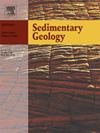Petrological and geochemical evidence of hematite growth and dispersal in Permo-Triassic red beds under the Pangea mega-monsoon climate, Colorado Plateau, Utah
IF 2.9
2区 地球科学
Q1 GEOLOGY
引用次数: 0
Abstract
The palaeoclimatic significance of continental red beds (CRB) is the subject of a long-standing debate. The CRBs are strikingly often found in association with arid, aeolian sediments, humid fluvial sediments and palaeosols, reflecting variable climatic regimes. In this study, diffuse reflectance spectroscopy (DRS) is used in combination with facies analysis, petrology, bulk-rock and in-situ major and trace element geochemistry, and molybdenum stable isotopes to better understand the origin and distribution of the hematite pigment in a spectrum of Permo-Triassic aeolian, fluvial and pedogenic facies of the Colorado Plateau, Utah. Their red colour is characterized by high (> 30) percentage of red-band (625–700 nm) reflectance in the DRS spectra and high hematite-to-goethite peak height ratios (1.5 to 5.7) from their first derivatives. Most hematite occurs in form of submicronic to micron-sized, platy crystals in altered biotite grains, clayey grain coatings, clayey matrix, pyrite framboid pseudomorphs, and as pore-filling cement. Hematite is most abundant in palaeosols, but also present in aeolian, sand dune and damp interdune deposits, fluvial channel-fill, sandy and gravelly bars, and floodplain deposits. Iron for the hematitization was supplied from reductive release of Fe2+ from biotite and clay minerals. The hematitization itself occurred under oxic conditions, associated with formation of kaolinite, mobilization of V, Mo, As, U, and fractionation of rare earth elements and Mo isotopes, especially in lateritic palaeosols. Hematitization during weathering, pedogenesis, transportation and early diagenesis, and reworking and redeposition of the red material by rivers and wind is thought to be the principal mechanism of the formation of red beds in the Colorado Plateau. The processes of hematitization and the fluvial-aeolian dynamics were controlled by alternation of wetter and drier periods likely caused by the Permo-Triassic Pangean mega-monsoonal climatic regime.
盘古大陆季风气候下二叠纪-三叠纪红层赤铁矿生长扩散的岩石地球化学证据
大陆红层(CRB)的古气候意义是一个长期争论的主题。crb惊人地经常与干旱、风成沉积物、潮湿河流沉积物和古土壤相关联,反映了多变的气候制度。本研究将漫反射光谱(DRS)技术与相分析、岩石学、块状岩石和原位主微量元素地球化学以及钼稳定同位素相结合,更好地了解美国犹他州科罗拉多高原二叠-三叠纪风成、河流和成土相光谱中赤铁矿色素的来源和分布。它们的红色特征是DRS光谱中红色波段(625-700 nm)反射率高(> 30),一阶导数的赤铁矿与针铁矿峰高比高(1.5至5.7)。大多数赤铁矿以亚微米至微米大小的片状晶体形式存在于蚀变黑云母颗粒、粘土颗粒涂层、粘土基质、黄铁矿似树状假晶和填孔胶结物中。赤铁矿在古土壤中最为丰富,但也存在于风沙、沙丘和湿丘间沉积物、河道填充物、沙质和砾石坝以及洪泛平原沉积物中。赤铁矿铁由黑云母和粘土矿物还原释放的Fe2+提供。赤铁矿作用本身发生在氧化条件下,与高岭石的形成、V、Mo、As、U的动员以及稀土元素和Mo同位素的分馏有关,特别是在红土古土壤中。风化作用、成土作用、搬运作用和早期成岩作用中的赤铁矿作用以及河流和风对红色物质的再加工和再沉积作用被认为是科罗拉多高原红层形成的主要机制。赤化过程和河流—风成动力学受二叠纪—三叠纪泛古巨型季风气候条件下的干湿交替控制。
本文章由计算机程序翻译,如有差异,请以英文原文为准。
求助全文
约1分钟内获得全文
求助全文
来源期刊

Sedimentary Geology
地学-地质学
CiteScore
5.10
自引率
7.10%
发文量
133
审稿时长
32 days
期刊介绍:
Sedimentary Geology is a journal that rapidly publishes high quality, original research and review papers that cover all aspects of sediments and sedimentary rocks at all spatial and temporal scales. Submitted papers must make a significant contribution to the field of study and must place the research in a broad context, so that it is of interest to the diverse, international readership of the journal. Papers that are largely descriptive in nature, of limited scope or local geographical significance, or based on limited data will not be considered for publication.
 求助内容:
求助内容: 应助结果提醒方式:
应助结果提醒方式:


